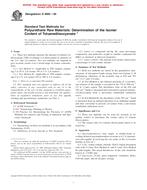1.1 These test methods cover the determination of dissolved and total recoverable lead in water and waste water by atomic-absorption spectrophotometry and differential pulse anodic stripping voltammetry. Four test methods are included as follows:
| Concentration Range |
Sections | |
| Test Method A–Atomic Absorption, Direct | 1.0 to 10 mg/L | 7 to 15 |
| Test Method B–Atomic Absorption, Chelation-Extraction |
100 to 1000 μg/L | 16 to 24 |
| Test Method C–Differential Pulse Anodic Stripping Voltammetry |
1 to 100 μg/L | 25 to 35 |
| Test Method D–Atomic Absorption, Graphite Furnace |
5 to 100 μg/L | 36 to 44 |
1.2 Test Method B can be used to determine lead in brines. Test Method D has been used successfully with reagent water, lake water, well water, filtered tap water, condensate from a medium Btu coal gasification process, waste treatment plant effluent, and a production plant process water.
1.3 It is the user’s responsibility to ensure the validity of these test methods for waters of untested matrices.
1.4 The values stated in SI units are to be regarded as standard. No other units of measurement are included in this standard.
1.5 This standard does not purport to address all of the safety concerns, if any, associated with its use. It is the responsibility of the user of this standard to establish appropriate safety and health practices and determine the applicability of regulatory limitations prior to use. For specific hazards statements, see 10.4.1, Note 2, 11.2, 11.3, 21.7, 21.8, 21.11, 23.7, 23.10, 32.2.1, and 33.1.
7.1 This test method covers the determination of dissolved and total recoverable lead in most waters and wastewaters.
7.2 The test method is applicable in the range from 1.0 to 10 mg/L of lead. The upper limits of detectability can be increased to concentrations greater than 10 mg/L by dilution of the sample.
17.1 This test method covers the determination of dissolved and total recoverable lead in most waters and brines.
17.2 This test method is applicable in the range from 100 to 1000 μg/L of lead. The range may be extended upward by dilution of the samples.
27.1 This test method describes the determination of lead in water and waste waters using differential pulse anodic stripping voltammetry.
27.2 This test method is applicable up to a concentration of 100 μg/L lead. Higher concentrations can be determined by dilution.
27.3 The lower limit of detection for lead is 1.0 μg/L.
Note 13 – The lower limit of detection for differential pulse anodic stripping voltammetry is not absolute and can easily be lowered by changing the experimental parameters as described in Appendix X1. However, these variations have not been interlaboratory tested.
39.1 This test method covers the determination of dissolved and total recoverable lead in most waters and wastewaters.
39.2 The test method is applicable in the range from 5 to 100 μg/L of lead using a 20-μL injection. The range can be increased or decreased by varying the volume of sample injected or the instrumental settings. High concentrations may be diluted but preferably should be analyzed by direct aspiration atomic absorption spectrophotometry (Test Method A).
39.3 This test method has been used successfully with reagent water, lake water, river water, well water, filtered tap water, condensate from a medium Btu coal gasification process, waste treatment plant effluent, and a production plant process water. It is the user’s responsibility to assure validity of this test method for untested matrices.
Product Details
- Published:
- 10/01/2008
- Number of Pages:
- 17
- File Size:
- 1 file , 200 KB
- Redline File Size:
- 2 files , 360 KB


